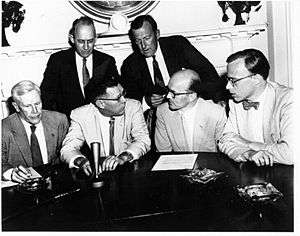Athelstan Spilhaus
Athelstan Frederick Spilhaus (November 25, 1911 – March 30, 1998) was a South African-American geophysicist and oceanographer. Among other accomplishments, Spilhaus is credited with proposing the establishment of Sea Grant Colleges at a meeting of the American Fisheries Society in 1963 as a parallel to the successful land-grant colleges, which he claimed was "one of the best investments this nation ever made. The same kind of imagination and foresight should be applied to the exploration of the sea."[1]
Athelstan Frederick Spilhaus | |
|---|---|
 Spilhaus is standing to the right during the announcement of plans for the building and launching of the world's first man-made satellite, July 29, 1955. (NASA) | |
| Born | November 25, 1911 |
| Died | March 30, 1998 (aged 86) |
| Known for | Bathythermograph |
| Scientific career | |
| Fields | Geophysics Physical Oceanography |
| Institutions | Woods Hole Oceanographic Institution University of Minnesota American Newspaper Publishers Association |
Biography

Spilhaus was born in 1911 in Cape Town, South Africa. In 1936, Spilhaus joined the Woods Hole Oceanographic Institution in Massachusetts, where he developed the bathythermograph, which made the measurement of ocean depths and temperatures from a moving vessel possible, a device which proved indispensable to submarine warfare. This invention established his international reputation.[2] He became a US citizen in 1946.
Later, he became Dean of the University of Minnesota's Institute of Technology.[3]
Spilhaus was the founder and original planner of the Minnesota Experimental City[4].
Spilhaus was also chair of the scientific advisory committee of the American Newspaper Publishers Association. He became known by the public for his Our New Age Sunday feature, which appeared in the color comics section of 93 newspapers (1957–1973).[5][6][7] The strip therefore was quite influential in its time and John F. Kennedy is cited to have said on a meeting with Spilhaus in 1962: "The only science I ever learned was from your comic strip in the Boston Globe."[8] He apparently enjoyed authoring the feature; in response to a question about its broad scope in a mid-sixties TV interview, Spilhaus modestly replied he'd learned quite a lot by writing it.
He also served on the board of trustees of Science Service, now known as Society for Science & the Public, from 1965 to 1978. In an interview for the American Institute of Physics he stated with reference to a question on his religious views that he was an Episcopalian[9]
References
- Spilhaus, A. F. (1964). "Man in the Sea". Science. 145 (3636): 993–993. doi:10.1126/science.145.3636.993. ISSN 0036-8075.
- "A Guide to the Athelstan Spilhaus Papers, 1912-2003 (bulk 1930-1990)". Dolph Briscoe Center for American History. Austin: The University of Texas. Retrieved 2018-06-05.
- "Retrospect: Athelstan Spilhaus, Spring 1998". Archived from the original on 2011-07-22. Retrieved 2011-01-13.CS1 maint: BOT: original-url status unknown (link)
- Epstein, Sonia (December 15, 2017). "The Experimental City: Director Chad Freidrichs". Sloan Science & Film.
- "Athelstan Spilhaus (obituary)". Fishlines. April 1998. Archived from the original on 2010-06-25. Retrieved 2007-01-16.
- "Dr. Athelstan F. Spilhaus, Scientist, Inventor, Educator and Syndicated Science Writer". The Sands Mechanical Museum.
- "Metric system cartoons". U.S. Metric Association. Archived from the original on 2007-01-17. Retrieved 2007-01-16.
- Novak, Matt (January 27, 2012). "Sunday Funnies Blast Off Into the Space Age". Smithsonian. Retrieved 2018-06-05.
- Doel, Ronald (10 November 1989). "Interview of Athelstan Spilhaus by Ronald Doel on 1989 November 10, Niels Bohr Library & Archives, American Institute of Physics, College Park, MD USA,". aip.org. Retrieved 2018-06-05.
Further reading
- Nierenberg, William A. (September 2000). "Biographical Memoir: Athelstan Spilhaus" (PDF). Proceedings of the American Philosophical Society. 144 (3). Archived from the original (PDF) on 2011-10-18.
- Gasperini, Jennifer Kimball (March 2, 2016). "The First 50 Years of Sea Grant: The Dazzling Dr. Spilhaus". Sea Grant. Retrieved 2018-06-05.
- Noble, Holcomb B. (April 1, 1998). "Athelstan Spilhaus, 86, Dies; Inventor With Eye on Future". nytimes.com. Retrieved 2018-06-05.
- "Athelstan Spilhaus". The Economist. April 9, 1998. Retrieved 2018-06-05.
- Knauss, John (27 October 1998). "Athelstan Frederick Spilhaus (1911–1998)". Eos, Transactions American Geophysical Union. John Wiley & Sons, Inc. 79 (43): 519–519. doi:10.1029/98EO00383.